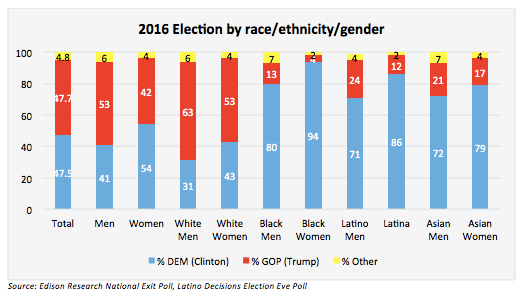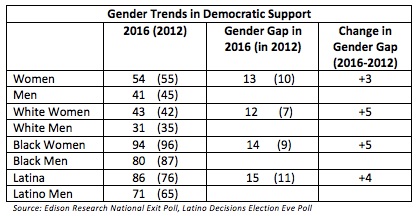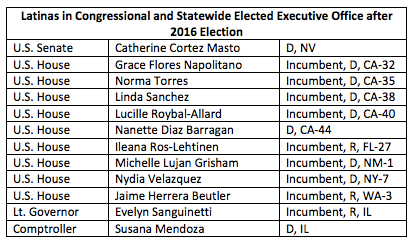Mixed Outcomes for Latinas in Election 2016
 In April 2015, the Barbara Lee Family Foundation (BLFF) and the Center for American Women and Politics (CAWP) launched Presidential Gender Watch 2016, a project to track, analyze, and illuminate gender dynamics in the 2016 presidential election. With the help of expert scholars and practitioners, Presidential Gender Watch worked for 21 months to further public understanding of how gender influences candidate strategy, voter engagement and expectations, media coverage, and electoral outcomes in campaigns for the nation’s highest executive office. The blog below was written for Presidential Gender Watch 2016, as part of our collective effort to raise questions, suggest answers, and complicate popular discussions about gender’s role in the presidential race.
In April 2015, the Barbara Lee Family Foundation (BLFF) and the Center for American Women and Politics (CAWP) launched Presidential Gender Watch 2016, a project to track, analyze, and illuminate gender dynamics in the 2016 presidential election. With the help of expert scholars and practitioners, Presidential Gender Watch worked for 21 months to further public understanding of how gender influences candidate strategy, voter engagement and expectations, media coverage, and electoral outcomes in campaigns for the nation’s highest executive office. The blog below was written for Presidential Gender Watch 2016, as part of our collective effort to raise questions, suggest answers, and complicate popular discussions about gender’s role in the presidential race.
Many of us are still in shock over this month’s election results, especially in light of the stalled advancement of women to our highest office. The election results also bring fears over the future ramifications of a Trump presidency including the worry of additional violence, intimidation, and loss of essential rights for many diverse groups in the U.S. We can try to move through this shock by taking a look at the election highlights for women of color, in particular for Latinas.
Increase in Minority Voters: The 2016 election marked the most diverse electorate in U.S. history, with thirty-one percent of eligible voters from racial and ethnic minorities or a net increase of 7.5 million eligible voters. In contrast, the share of the white non-Hispanic eligible voters hit an all-time low of 69 percent. In particular, Latinos increased their number of eligible voters by another 4 million to reach a record setting 27.3 million eligible voters, which is the largest increase of any racial/ethnic group. Despite these gains in the share of the electorate, many diverse potential voters also faced increased voter intimidation and suppression efforts. This year marked the first presidential election in 50 years without the full protections of the Voting Rights Act. This election included fourteen states implementing their new voting restrictions, including strict voter-ID laws and extreme cuts to voting locations/hours. More investigation is needed to realize the ramifications of these voter restrictions.
In spite of the voting obstacles in place, Latino voter turnout increased significantly compared to the 2012 election. It is estimated that 13 to 14 million Latinos voted in the election, which is an increase of 2-3 million since 2012. Moreover, Latino voters overwhelmingly supported Hillary Clinton by an estimated 79 percent. Note, there is disagreement among the national polls over the true level of Latino support for Clinton; I choose to utilize the Latino Decisions polling numbers as the most accurate representation of Latino support. In fact, this Latino support of Clinton increased significantly compared to recent presidential elections when Democratic candidate Barack Obama won a substantial show of Latino support by more than 67 percent in 2008 and 72 percent in 2012.
Women of Color and the Gender Gap: In the 2016 election, 54 percent of women and 41 percent of men supported the Democratic candidate Hillary Clinton, a 13 point gender gap. Women were 12 points less likely than men to support Donald Trump, yielding a 12 point gender gap; this gender gap was up by two points from the 2012 election. Among whites, the gender gap in support of Clinton was at 12 points (43 to 31 percent). This follows the recent trend of the majority of white women, 53 percent, supporting the Republican presidential candidate instead of the Democratic candidate, which also happened in both 2008 and 2012. While precedent would have predicted this behavior by white women, the results are contrary to some expectations that Clinton would receive more support from white women than previous Democratic nominees because they share both her racial and gender identity.
This recent trend also highlights the growing role of women of color to reinforce the modern gender gap in the U.S. Minority voters overwhelming supported Clinton, especially among minority women. This year the gender gap in support of Clinton was 14 points among Blacks (94 to 80 percent), which was 5 points larger than the gender gap in Black voter support for Obama in 2012. Among Latinos, the gender gap in support for Clinton was 15 points (86 to 71 percent), a growth by 4 points compared to 2012. Further, the gender gap in support of Clinton was 7 points among Asian Americans, with Democratic support coming from 79 percent of Asian American women compared to 72 percent of Asian American men. In addition to women of color’s strong show of support for Clinton in this election, we know they also represent a growing electorate that will continue to have a more dramatic impact on American politics. So, when we talk about the modern gender gap in support of the Democratic candidates, we need to focus on the growing role of minority women.


Clinton Campaign Highlights Role of Latinas: Latinos across the country were able to unify across the country in defense of a common enemy, which many saw in Trump’s anti-Latino, anti-immigrant, and sexist rhetoric. Moreover, Clinton’s campaign featured a prominent role for Latinos, in particular for Latinas. The campaign employed Amanda Renteria as the national political director and Lorella Praeli as the Latino Outreach Director. In addition, the DNC utilized several prominent Latinos/as for featured speakers during the national convention. Many prominent Latinas also served as campaign surrogates during the campaign, including former Miss Universe Alicia Machado. The Clinton campaign also employed a Latina-specific campaign strategy to court Latino voters by using Latina community leaders.
Increase in Latina Elected Officials: Congress will now include the highest level of Latino elected officials with a record 38 Latino members. This includes 10 total Latinas in Congress, which increased by one, with a gain of two new members and loss of one. Catherine Cortez Masto (D, NV) became the first Latina elected to the U.S. Senate. She was Nevada’s former attorney general and will now replace the outgoing Democratic Senate Minority Leader Harry Reid. An additional Latina was elected to the House of Representatives: Nanette Diaz Barragan (D, CA-44). At the statewide level, Latinas increased their presence from 1 to 2, with Susana Mendoza (D, IL) elected to serve as the first Latina as a State Comptroller. In addition, Latinas will make history in the Colorado state legislature, since the election marks the first time a state will have two Latinas leading the Senate and the House. In January, Crisanta Duran will be the Colorado House speaker, and Lucia Guzman will serve as the minority leader in the Colorado Senate.

More Diverse Women Elected: Moreover, women were able to make history in other offices across the country. The U.S. Senate will include a record number of women of color, with three additional women pushing the total to four women of color Senators. The three women to join Asian American Mazie Hirono (D-HI) in the Senate include Tammy Duckworth (D-IL, Asian American), Kamala Harris (D-CA, Black and South Asian), and Catherine Cortez Masto (D-NV, Latina). The 115th U.S. House will also include several path-breaking women in office. They include Pramila Jayapal (D-WA), the first South Asian woman to serve in the U.S. House, and Lisa Blunt Rochester (D-DE), the first woman and the first Black woman to represent Delaware in Congress. At the statewide level, Democrat Kate Brown in Oregon is the first openly LGBTQ+ governor to be elected in the U.S.
Overall, this election brings extreme disappointment and worry about the future possibilities for gender and racial politics in America. However, there are several accomplishments of note for women of color that can point to a more bright future.

